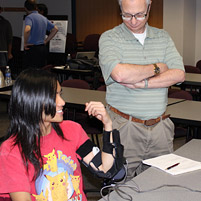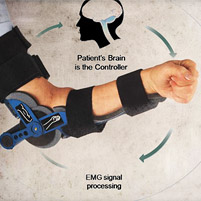Acting on an Idea

Professor Dan Siewiorek observes demonstration of the Myomo's robotic arm.

When part of the brain is damaged by a stroke, other parts of the brain will step up and take over the lost function.
But how do you teach the brain to do that?
"In the case of Myomo's robotic arm, you put the device on and when you think about moving the limb, it actually works," said CMU's Dan Siewiorek, a pioneer in mobile computing.
The essence of the technology is a sensor that fits against the skin on the arm and acts like a microphone. It listens for muscle signals.
When it hears a signal, it passes it to the software which tells the robotics how much assistance to apply.
The challenge for Myomo, however, was how do you motivate patients to keep at their therapy?
Siewiorek, the Buhl University Professor of Computer Science and Electrical and Computer Engineering, also leads research for the Quality of Life Technology Center's (QoLT) Human-System Interaction Thrust and its Virtual Coach Testbed Systems.
He turned to his students for ideas.
Interfacing the Myomo system to video games was a pilot project for a team of three students in the fall 2010 version of CMU's Mobile and Pervasive Computing course co-taught with M Satyanarayanan.
"The students created a monitor of arm joint angle versus time — a display that thrilled the clinician. She had never seen such a graph and immediately saw the potential for scaling exercise routines to the ability of the subject," Siewiorek explained.
Within the scope of the project, they also mapped the joint angle to control a classic game joy-stick controller. Then they worked with a stroke survivor, who volunteered to play video games.
The game they devised pitted a lion tamer against a hungry feline. The patient had to move the robotic arm to keep the lion tamer from being eaten.
In addition to exercising the affected arm, the game provided practice in synchronizing coordination between both arms.
"Myomo was extremely impressed with how quickly the students learned their system, wirelessly collected data from the Myomo arm, and mapped the data to control whole families of video games," said Siewiorek.
"The student's accomplishments went way beyond the company's expectations. It was a very impressive performance by the students."
Myomo was so impressed that the company is now looking to gaming as an integrated part of its therapy solutions.
"We credit the CMU student team with not only the development of, but also the idea behind, the myProgress app," said Myomo's CEO Steve Kelly. "From a development standpoint, the team has been practical and innovative at the same time."
Myomo has sought small business translational research funding to continue its collaborations with the QoLT center and Siewiorek's students.
QoLT is a National Science Foundation Engineering Research center focused on creating intelligent systems that enable older adults and people with disabilities to live more independently.
The Myomo findings on user engagement and motivation will inform other projects currently underway at the QoLT center such as the development of service robots, smart assistive technologies and virtual coach systems that help improve therapy compliance and enhance rehabilitation results.
Related Links: Quality of Life Technology Center | School of Computer Science | Electrical & Computer Engineering
